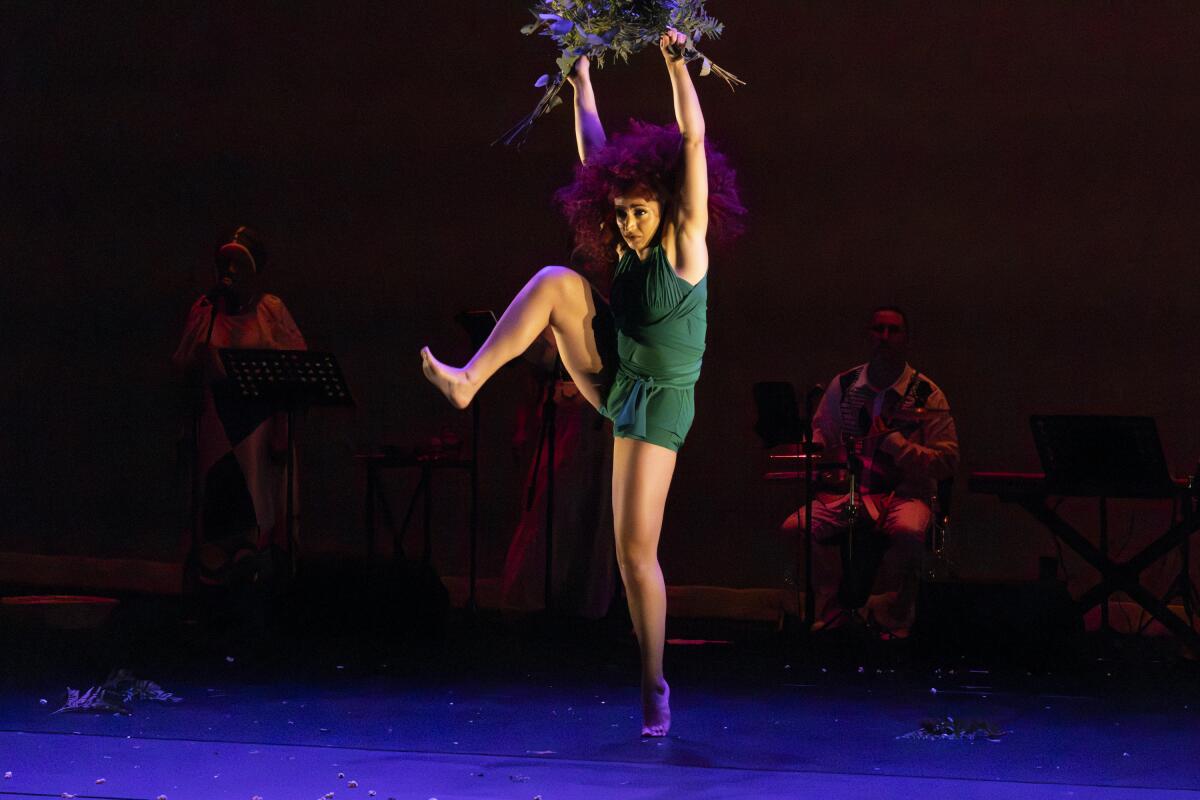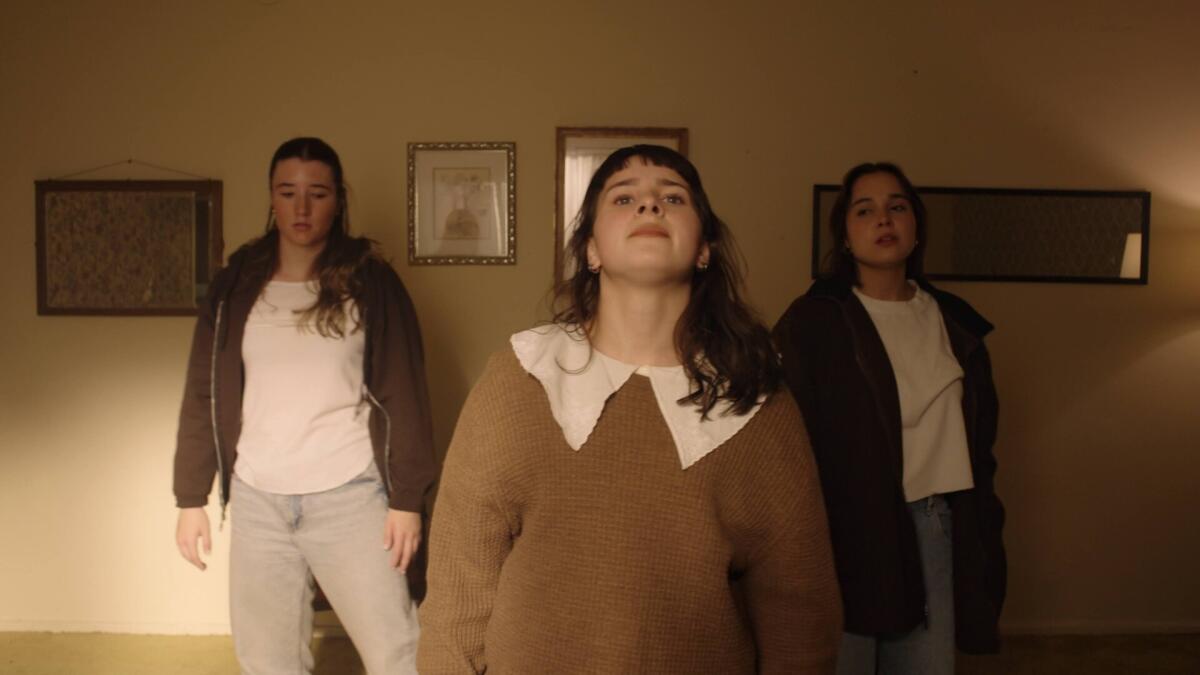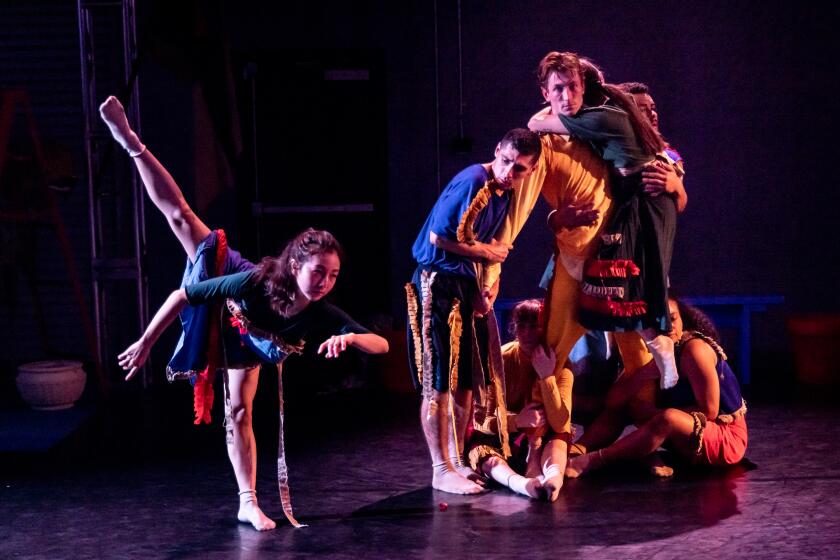‘A state of emergency’: How L.A. dance groups are pivoting amid steep funding cuts

- Share via
Linda Yudin was sipping coffee with family and friends on May 3, the morning of her birthday, when they warned her not to check her emails.
Later that afternoon, she learned why: Her dance company, Viver Brasil, had lost a $20,000 grant. It was among 30 Los Angeles arts organizations that received a grant termination letter from the National Endowment for the Arts the night before.
“Was I mad? Yes, I was mad. I was really angry. We were all really angry because it slows our process down,” Yudin, Viver Brasil’s founding artistic director, told The Times.
Nonprofit dance company Pointeworks creates opportunities on and offstage for women, including choreographers and composers, during ballet’s off-season.
The money was intended to support staff salaries and artist fees for a national tour of “Rezas e Folhas (Prayers and Leaves),” choreographed by co-artistic director Vera Passos. The piece blends Afro-Brazilian and Indigenous dance with experimental choreography to examine the climate crisis and social change — subjects playing out in real time in L.A.
Now, Viver Brasil has to pause and reevaluate what that tour will look like. Possible adjustments include performing in smaller venues and cutting down the size of the cast.
“We have to rethink perhaps, but I’m proud to be part of such a creative dance ecosystem,” Yudin said. “We dance hard, we fight hard, and that’s what we do.”

Dance is one of the most underfunded arts disciplines, according to Raélle Dorfan, executive director of L.A.’s Dance Resource Center. She points to inherent economic challenges that inhibit the industry’s infrastructure and growth potential — such as limited funding sources — which consequently can make it challenging for companies and venues to fill seats.
With the stress of federal and local funding cuts, as well as the January fires, many L.A. dance organizations are scaling back their programming and outreach. While small nonprofits and underserved communities have been impacted the most, larger companies are feeling the pain as well.
“We’re really in the middle right now of compounding crises,” said Gustavo Herrera, chief executive of Arts for LA. “It’s really a state of emergency for arts organizations.”
National Endowment for the Arts, facing an existential threat from President Trump, cancels grants for L.A. Theatre Works, L.A. Chamber Orchestra and other groups — some of which already spent the funding based on an NEA recommendation.
Uncertainty from the NEA
Arts organizations across the country have been reeling from NEA grant terminations amid priority changes under President Trump’s administration. Twelve L.A. organizations are currently at risk of needing to eliminate jobs and programming due to federal funding cuts, according to Herrera.
In his 2026 budget proposal, Trump has called to eliminate the NEA, the largest arts funder in the country, altogether — a proposal he also made in his 2018 budget that failed to move through Congress. In response, a group of senior officials resigned from the agency, including dance director Sara Nash. Dance specialists Kate Folsom and Juliana Mascelli followed suit, leaving the NEA without an active dance division.
These sudden changes have proven frustrating for many companies, including Dance Camera West, which received a termination letter for its $15,000 grant.
“For an organization our size, you have to be so nimble,” executive director Kelly Hargraves said. “Because we’re dancers, we know how to pivot. And we have to pivot every single year based on which grant we did get and didn’t get, and change what we’re doing and not doing.”
Alec Cohen’s weekly Intro to Popstar Dance class promises that, in just 90 minutes, participants will ‘realize they have permission to be fabulous in their everyday lives.’
Hargraves had already spent the money before receiving the termination notice and, to her knowledge, does not owe any of it back. Still, she’s concerned about future funding and has decided to cut the Visibility commission project — which supports the creation of new dance films from underrepresented artists — for the next Dance Camera West festival.
“I was joking that I should basically just take my old applications and put the word ‘not’ in front of everything,” she said, “because it’s a very DEI program.”
For her 2026 grant application, Hargraves wrote a proposal for a series of documentaries about the great masters of dance and dance film, including Martha Graham, Anna Sokolow and Shirley Clarke. But she, like many other company directors, has been left in the dark regarding the status of her application.
“I’ve sent emails that don’t get responded to,” she said. “I feel like I’m that emoji with the hands in the air. Let’s just do what we can, not count on anything.”
L.A. Dance Project, founded by acclaimed choreographer Benjamin Millepied, also has a pending $66,744 grant application for Launch:LA, its residency program for emerging artists. Each year, the company supports two projects by providing three weeks of rehearsal space, a stipend and production resources. The program culminates with performances at the company’s downtown performance space.

While Launch: LA is partially funded by private foundations and individual donors, receiving the full amount from the NEA would make it possible to offer the program biannually, supporting four projects each year. But until L.A. Dance Project hears back, the company is focused on safeguarding its current annual offering.
“To get this kind of news and see our colleagues experiencing this sort of rug being pulled out from underneath them, it’s difficult,” said Rachelle Rafailedes Mucha, director of foundation and government grants. “We just are now trying to share the case for arts funding, and we need the private foundations and the individuals and our local and state agencies to step up and fill the void of what’s happening with the NEA.”
Payroll challenges
Keeping employees on the payroll presents another challenge for small dance organizations — especially after AB5, which makes it more difficult for companies to classify their workers as independent contractors, went into effect in 2020. This means many arts groups have had to reclassify workers as employees, leading to increased expenses to cover payroll taxes, overtime pay, paid sick leave and more.
The Performing Arts Equitable Payroll Fund was implemented in March to help performing arts companies comply with AB5 by reimbursing a portion of their payroll costs. The $11.5 million allocated for PAEPF was put on the chopping block in Gov. Gavin Newsom’s May proposal but was ultimately restored in the final budget.
Still, it can be difficult to secure funding through the PAEPF due to high demand and the first-come, first-served nature of the program. Hargraves is currently on hiatus from Dance Camera West until the fall in order to reduce administrative costs.
“[The PAEPF] would make it feasible for me to be on salary again,” Hargraves said. “Obviously I keep working because I’m not going to let [Dance Camera West] die in the meantime. But I still have a day job or two or three.”
Choreographers whose works were performed in Los Angeles this year share how the pandemic, as well as loss, stillness and joy, reshaped their perspective and practice.
County budget cuts
On the county level, the Department of Arts and Culture budget was slashed by $1.7 million this month, impacting its organizational grant, community impact arts grant and arts internship programs, according to the department’s website. At least 17 dance companies are at risk of losing their funding because of these cuts, said Herrera.
The Organizational Grant Program, which provides two years of funding to grantees, offers money for general operating costs, not just specific projects. Grantees for the 2024-2025 fiscal year were first paid in November 2024 and will receive money again this November. Their promised funding will not be affected by the cuts, according to the department’s website.
Yudin, whose company was granted $23,600 last year to support director salaries and invest in a new position, said she deeply values the funding Viver Brasil has received from the county. “Is it enough? I think we all recognize that it is not enough, but it is an important recognition, and we appreciate that very much.”

The City of Los Angeles Department of Cultural Affairs also faced steep cuts in Mayor Karen Bass’ proposed budget, but the funding was ultimately restored in the final version. The DCA was the only department whose funding wasn’t cut, according to Arts for LA.
‘More than dance’
Funding cuts to the arts affect more than just the arts, said Herrera. A study commissioned by Arts for LA found that for every 100 performing arts jobs, there were an additional 156 jobs supported in other sectors.
“It activates entire neighborhoods and communities,” Herrera said. “We really feel that elected officials need to do more to come to the table and support this sector, because at the end of the day, it impacts the bottom lines of cities, regions, states, countries.”
In Orange County, Anaheim Ballet did not receive its $10,000 NEA grant to support Step-Up!, an afterschool program that provides free dance classes to youth. The money would have come through the Challenge America grant — canceled by the NEA for the 2026 fiscal year — which supports arts programs for underserved groups and communities.

Anaheim Ballet will continue to offer classes to underserved youth, but it now relies on private donations, other grants and funds shifted from other operations.
“We just want to make sure they’re able to dance if they want to. There are kids, young people, that do want to, and it’s prohibitive for many families that are struggling just to make ends meet,” said executive director Lawrence Rosenberg. “From day one, from our inception, we saw the need. It’s always been a part of what we do. Our go-to slogan is ‘Anaheim Ballet: more than dance.’
“The point is we think that people respond to something in ballet when it’s more than dance — when you’re seeing persistence and hope and effort and things that we can all relate to, whether it’s dance or any other area of our lives that we know is worth struggling in.”
More to Read
The biggest entertainment stories
Get our big stories about Hollywood, film, television, music, arts, culture and more right in your inbox as soon as they publish.
You may occasionally receive promotional content from the Los Angeles Times.















